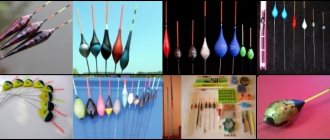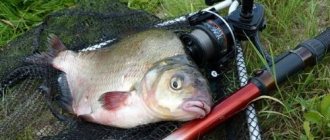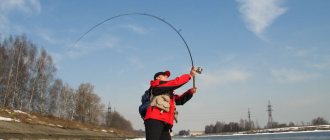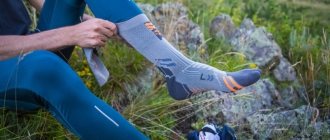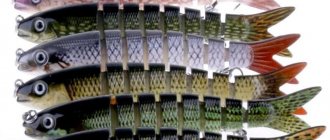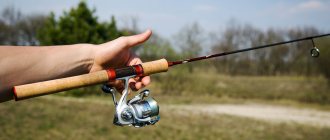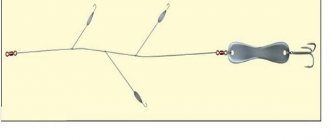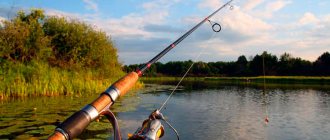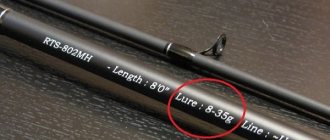Spinning is a sporting tackle designed for hunting “serious” fish. The word “spinning” is derived from the English word Spin, meaning “to spin.”
Only the reel rotates, this is what makes an ordinary fishing rod a spinning rod. You can fish with natural and artificial baits.
If certain fishing conditions are met, you can throw it far and accurately when:
- good fishing spot;
- proper choice of bait;
- proper operation of the rod.
Components of spinning tackle
Main elements: rod, tip, reel, handle, butt, fishing line, guides, whip, leash.
Rod
The rod is the main element of the entire tackle.
It is necessary to immediately take into account several points of the upcoming hunt:
- size of the reservoir;
- type of fish;
- maximum load weight;
- type of fishing line.
There are 2 types:
- telescopic - consist of many sliding parts;
- composite - usually assembled from two.
When purchasing, study not only prices, but:
- length, weight;
- design of rings, joints of elbows, etc.
- material of manufacture;
- construction of the form.
The light class blank can be operated with one hand, it has a length of 1.70-2.5 m, the length of the medium class is 2-2.50 m, and the heavy class is 2.50-3 m.
Coil
To equip the form there are 3 reel options:
- Inertial is an outdated option, but still used. The main disadvantage is the formation of a “beard” from the fishing line, which often forms when casting. There is no braking mechanism, but some models are equipped with such a device.
- Inertialess - most popular. The handle is attached on either side, adapting to the person. Versatility of use - starts with ultralight and ends with trolling. Equipped with a spool or drum. When casting, the braking mechanism is not used. Suitable for long casts. Equipped with a friction device that can be adjusted: speed and traction. Differ:
- by number of bearings;
- rotation handle;
- type of drive mechanism.
- Multiplier - combines the 2 previous types. Characterized by complete control over the tackle and ease of casting. They have a centrifugal type of braking. The braking force will depend on the weight; it is used as a braking mechanism.
Inertialess
Inertial
Multiplier
fishing line
Has the following parameters:
- different breaking capacity;
- manufacturing materials;
- thickness and color.
There are 3 varieties:
- braided cord;
- monofilament;
- fluorocarbon.
All types have their pros and cons. For each specific fishing trip, only one specific option is suitable.
Advantages of monofilament:
- slight resistance;
- you can make it so that in the water it will be either completely invisible or noticeable, as desired;
- stretches greatly;
- slight friction during operation;
- small price.
Disadvantages : not durable, will stretch a lot when jigging.
Advantages of braided cord:
- does not stretch;
- has the greatest strength;
- durable;
- unpretentious in operation.
Disadvantages : quite expensive, if fishing in an unsuitable area it will not last long, will become disheveled, suitable only for ideal ruts and a high-quality reel.
Advantages of fluorocarbon:
- invisible in water;
- abrasion resistant;
- has almost zero elongation;
- does not absorb water;
- You can hunt right up to the freeze-up.
Disadvantages : similar to monofilament fishing line, you need to be able to distinguish.
Fluorocarbon line
monofilament
Braided cord
Bait
The following types are used for spinning tackle:
- Spinner (spinner) - looks like a shiny fish, there is a petal on the axis. When wiring, it begins to spin, adjacent to the axis, high-frequency rotations are formed.
- Oscillating (oscillator) - curved in shape, has a metal body. On one side there is a hook, on the other there is a hole for fishing line. When wiring, low-frequency oscillatory movements are formed, reminiscent of the movements of a fish.
- Rubber - twisters, similar to a worm of varying thickness. The body is short, the tail is curved. Made from silicone. When retrieving, the tail begins to vibrate, it resembles more a fish than a worm.
- Rubber - vibrotails , outwardly very similar to fish, only silicone. The tail is wide; when retrieved, it will move in different directions.
- Wobblers are made of plastic and come in a variety of shapes, sizes and colors. They can be surface and deep-sea. In some models, a blade is mounted in the fish’s mouth, this helps the bait go deeper. They differ in the degree of buoyancy.
- Castmaster is a surface spinner, has good aerodynamic characteristics, and can make ultra-long casts. But it has quite a lot of weight, suitable for ide, asp, and chub.
- An artificial fly is good for rigs with sbirulino and a heavy float, or together with a sinker. It has the shape of a hook with feathers. One such fly, or several pieces, are attached to leashes.
- Devon is an elongated spoon with a blade. During wiring, it will rotate, forming vibrations and attracting predators.
- Spinnerbait - is similar to a “rocker”, at one end it has a petal, at the other there is a silicone fly, or something like a squid. It looks like a living creature, arouses interest with its bright colors and low-frequency or high-frequency vibrations.
Castmaster
Oscillator
Artificial front sight
Devonian
Spinnerbait
Twister
Pinwheel
Vibrotail
Wobbler
Equipment for fishing on the current
The specificity of fishing on rivers is such that the bait on the hook must be quickly delivered into the depths. In addition, the rig’s own windage should be minimal. If the current is not very strong, a basic rig for fishing in lakes and canals will do just fine.
Only the main weights should be moved to one point and lowered a little closer to the hook (in photo 3 - Fig. 1). However, this option for installing equipment when fishing with wires is prone to frequent overlaps and tangling. To make your life easier, I recommend using olive weights, removable (photo 4) or sliding. Such equipment gets tangled much less, and adapting them to fishing conditions is much easier.
Which type of “olive”, fixed or sliding, is better is a controversial issue. I like to use sliding “olives” in cases where strong holding of the equipment is required, and the bait on the hook must drag along the bottom (in photo 3 - Fig. 2). In this way I often catch bream, podust and dace.
I always place at least two pellets closer to the hook. Their purpose is to reduce the inertia of the main load when biting. During the fishing process, I often move them up and down the line, thereby adjusting the gear to changing fishing conditions.
Loading floats Stick . In my arsenal of floats for fishing on currents there are unusual floats that are ideal for light fishing with short, up to 15 m, retrieve on rivers with a uniform moderate current. The peculiarity of these floats is that their body consists of two materials of different densities: the top of the float is made of light balsa, and the keel is made of plastic (photo 6) .
Thanks to this combination, Stick are very sensitive to bites. But their main advantage is that when properly loaded, the movements of the bait on the hook look unusually realistic.
To load Stick floats, I most often use the so-called “button pattern” for placing weights on the fishing line ( pictured 3 - Fig. 4). The sinkers are attached to the fishing line at the same interval - approximately 15 cm. In this case, their mass decreases as they move away from the float.
This arrangement of sinkers turns out to be very effective when fishing with light rig holds. At the same time, the bait slowly rises and again falls seductively to the bottom. If you have to fish at a depth of more than one and a half meters, I double the upper pellets, and 20 - 30 cm above the float I attach a small pellet to the fishing line, which slightly submerges the fishing line, thereby stabilizing the movement of the float in the water.
But these rigs also have one serious drawback: when casting over the head, the sinkers evenly distributed on the fishing line can get tangled. It is best to fish with this equipment when the equipment is pulled along the tip of the rod, and it is best to cast it with a side horizontal cast. This way the float will always point up and the hook will always point downstream.
I hope my tips for installing float rigs will help you correctly configure the rig for existing fishing conditions. Tight line for you!
- A rod with a reel is easier to use and transport.
- In a fishing rod without a reel, the line is attached to the tip of the rod, and the equipment is stored on a special reel separately from the rod. This rod is lighter than a rod with a reel and you can choose a longer option.
What characteristics should the constituent elements have?
Rod
The first number is the test form, it is indicated in grams. Shows the upper and lower limits of the baits used. Based on these characteristics, one more thing can be determined - power.
The length is no less important; it is written on the form in centimeters. Then the material of manufacture is indicated, and sometimes the recommended line load is indicated.
Any form can be characterized by certain parameters:
- Build - this is a certain form of bending that the form acquires under the influence of load. It can exceed the upper limit of the bait test by a factor of two or more. Classification system:
- fast (F) (high-speed) - the form will bend by more than a third;
- medium (M) (moderate, mediocre) - the upper two-thirds will bend;
- extra fast (EF) (super-fast, quiver-type, apical) - the greatest bend in the upper quarter of the blank;
- slow (S) (quiet, parabolic) - the entire form will bend, almost to the very handle.
- Bait test - shows what kind of bait, under what conditions, hunting is possible. The manufacturer usually indicates 2 values - the lower and upper limits. Example - test 8-25 g. The bottom number 8 indicates the smallest weight of bait that can be effectively delivered with a spinning rod. The number 25 is the top one, indicating the maximum weight of the bait being thrown, so as not to overload the form. If you hunt with a bait whose weight is even less than the bottom one, the accuracy of your throws and the flight range will decrease. But if you exceed the upper limit, the form may even break.
- Line test — it is permissible to use fishing lines only with a specified breaking load. The range from smallest to largest is called a test:
- The smallest load will exceed the force that is generated during operation of the form. When it is smaller than necessary, then it may break during casting or hooking.
- The greatest is the maximum permissible load that the form can withstand.
If you use a fishing line that has a breaking load that exceeds the test, the spinning rod will fall apart. The test is the power of the rod. - Length — it is determined by the casting distance, the ability to control the nozzle during the retrieve:
- 2.5 - 3.4 m - used for hunting from the shore, distant casting;
- 2.3 - 2.8 m - the most popular, both for the boat and the shore;
- 1.5 – 2.3 m - for special types of wiring;
- 2.4 - 2.8 m - ideal for beginners.
Coil
If it has the following characteristics, it will serve for a long time:
- Be of high quality.
- The case must only be metal.
- Choose a medium size.
- Have a smooth ride, check before purchasing.
- The play should be minimal, the fastening should be reliable.
- The optimal number of bearings is 3.
- Spool size - from 2000 to 35000.
- There must be at least 70 m of line on the reel.
Line or cord
All fishing lines can be divided into 2 types:
- monofilament;
- wicker
Monofilament consists of 1 thread. Wicker - made of several layers, they are tightly intertwined. There are no particular differences between them. A high-quality monofilament line should have an equal cross-section along its entire length.
This line has different degrees of rigidity, the stiffest will be stronger, but will be subject to refraction. Braid is used for larger fish; it has increased strength.
There is only one drawback - there will be difficulties in tying knots. And too noticeable in the water.
Choosing fishing line for hunting:
- For heavy jigs, or for jerk baits, take only the line.
- For large fish up to 1 kg at medium depths and clear water, use fluorocarbon line.
To summarize, the sensitivity of the cord is excellent, but for “damping” jerks, fishing line is preferable.
Leash
It should be:
- strong;
- unnoticeable.
The length will depend on:
- type of nozzle;
- length of the form;
- fisherman's experience;
- maneuvering methods.
The ideal length for a two-handed blank is about 80 cm. Some spinning players have a favorite leash length of 30-40 cm.
For a one-handed one, it is considered ideal to be at least 50 cm, the main thing is that it should not be more than 80 cm. If it is more, then casting will be extremely inconvenient.
Hooks
Small hooks are used more often, with rare exceptions. Mostly No. 11-18.
The choice of shape and size will depend on:
- depending on the fishing circumstances;
- size and type of fish;
- size and type of bait.
The more capricious the fish, the more inconspicuous the equipment should be. But if the hook is greatly reduced, the possibility of predators gathering will increase.
Swivel
A swivel, or also called an anti-twist, is a tiny device that helps the fishing line not to twist from spinning: Devons, spinners, lures, swinging spoons.
It has a convenient latch, but not always. You can change the bait without tying or tearing.
Fluorocarbon
A relatively recent invention. Appeared in 1971 in Japan. Artificial polymer. Its advantages include the following:
- Resistant to aggressive environments, including physical ones.
- Does not change its properties in severe frost and extreme heat.
- UV resistant.
- They do not get wet or swell in water.
- Heavier than a regular leash or nylon leash.
- Softer, which makes the bait play more attractive and natural.
The disadvantages of fluorocarbon include:
- Less abrasion resistance.
- Less resistance to the teeth of predatory fish.
- Less breaking load.
- The cost of fluorocarbon fishing line is high, since the production cost is higher than nylon fishing line.
Suitable for fly fishing, pike perch, perch or for use when fishing for non-predatory fish. This material is not suitable for using fluorocarbon when fishing for pike or when fishing in a reservoir with a rocky and snagged bottom.
Separately, it is worth mentioning that recently a whole series of nylon fishing lines coated with flucocarbon has appeared on sale, which gives the fishing line the properties of this material. Such fishing lines are cheaper than a product made entirely of fluorocarbon.
Key characteristics of a spinning rod
Three main characteristics:
- test;
- length;
- build.
Test
This is the first characteristic; it is stated in grams.
It indicates the lower and upper permissible limit of the baits used, three main classes:
- light (LIGHT) - test 7-10 g;
- medium (MEDIUM) - test 10-25 g;
- heavy (HEAVY) - test 25-60 g.
There are also a lot of intermediate ones:
- medium-light;
- medium-heavy class.
The choice of these parameters will determine the quality and ease of control of the form when throwing:
- 1 value shows the minimum weight of the bait used;
- 2 value - maximum weight.
For any fish, you need to determine the approximate power of the blank; stick to the average value. An example is when the blank weighs from 10-20 grams, which means the ideal weight of the bait is 15-30 grams.
Build
Build is a short-term characteristic.
It shows how quickly the rod can react to a change in load, it depends on:
- whip material and thickness;
- arrangement of rings.
Length
For a variety of fishing conditions, different lengths are needed. A longer length helps: diversify the wiring, better maneuver the nozzle, change the wiring horizons.
But the most important thing is ease and confidence when playing hooked fish; its sharp jerks will be easily dampened. The length will depend primarily on personal preferences, and only secondarily on fishing conditions.
Installation
Everything seems to be simple. Everyone knows what a drop shot is - at the end of the line there is a weight, and above that there is a hook. But, for example, I didn’t find any restrictions; is it possible to place the hook on a short leash? On the contrary, on YouTube they recommend doing this specifically for nano-dropshots! And I, having tried both the “classic” and the version with a leash, came to the conclusion that for catching leucorrhoea, a leash is necessary. But since it is SIGNIFICANTLY shorter than the outlet for the load, the “heel strike” for amateurs, that is, the feeling of a bite, has not gone away, and even, it seems to me, has not been blurred, unlike the other spaced-out equipment that was discussed here - the outlet leash.
Accordingly, my installation looks like this:
I usually tie it on a leader line. The outlet for the sinker is 25-40 cm, depending on the conditions and the horizon in which the fish is kept. I suspect that in other bodies of water this distance may also decrease or increase. Very roughly, we can give advice here that this size will also depend on the desired species composition and its typical behavior: for bottom fish (goby, crucian carp, perch) - less, for pelagic (bleak, roach, rudd) - more.
The leash is about 5-7 cm long. Why is it needed? As far as I understand, the suction power of the leucorrhoea bait is very small. And if there is no leash, then it is difficult for her to properly retract the hook along with the bait. When I fished with a “classic” drop-shot rig, the results of the leucorrhoea bites were very sad. A leash more or less solves this problem. In addition, from personal experience using this equipment, I was convinced that the leash also “softens” the wiring, and for catching non-predatory fish this is a very useful “side effect”
Sinker. Here is one of my “know-how”. Maybe I wasn’t the only one who thought of it, but then it “came to me” without any prompting!
To prevent the sinker from twisting the line, I put a sliding float olive, and below I knit a stop bead. This design of the sinker rotates freely around the fishing line, much easier than on a swivel. And besides, in the event of a break, the cost of the lost equipment does not include the cost of the swivel!
Although it can be even cheaper. Someone simply clamps the required number of float pellets onto the fishing line.
Regarding the weight of the sinker... Yes, I use 1 gram, and I call it “nano”. But the main idea of the “nano”, it seems to me, is the size of the bait and the smoothness of the presentation, and, accordingly, the less predatory species composition of the trophies. So, I suspect that there are conditions where even an ounce will be “nano”. For example, where there is great depth and a very powerful current.
Features of equipment installation: example
Let's prepare the components:
- Medium action blank, up to 3 m long.
- Reel, size - up to 3000.
- Monoline - Ø 0.26 mm.
- Braided - 0.1 mm.
For a spinning fishing rod with a feeder:
- Rod - 3 m, test - 30-50 g.
- A reel, preferably a spinning one - 100-150 m.
- The feeder is cylindrical, but it can also be square, it will also serve as a sinker.
- The bite alarm is electronic.
- Stand type - rod-pod.
Features of equipment for different types of fish
Spinning is a highly sporting tackle for “serious” fish: pike, salmon, trout, pike-perch.
Pike
The pike requires the following components:
- A fishing rod, better than average action, 2 m, but more is possible.
- Monofilament - Ø 0.38 mm.
- A reel with a friction brake and a spool size of 4000.
- Metal leash, preferably rigid.
- Bait: spinners, vibrating tails.
Perch
For perch you need to prepare:
- Only fast action rod - up to 3 m.
- If the bottom is dirty, use monofilament; when clean, use braided wire - Ø 0.19 mm.
- Reel with adjusted friction brake, size - 3000.
- Bait: twisters, spoons, vibrotails.
Zander
Let's prepare the components:
- The rod is 2.5 m long.
- Reel with baitrunner function and adjusted friction brake.
- Spool from 2000 to 3500.
- Film - Ø 0.40 mm.
- Bait - any bait of your choice.
Trout
To equip you need to prepare:
- Fast action spinning rod - 2.5 m.
- Braid - Ø 0.30 mm.
- Multiplier reel - 16000.
- Bait: wobblers, spinners.
Tips and tricks
Some tips:
- If the bite is weak or non-existent, change the bait and fishing location.
- For beginners, it is better to use vibrating tails as bait.
- Oscillating spoons are not recommended for novice fishermen because they require not only experience, but also special fishing skills.
- You need to take a spare liner and spool when fishing.
When purchasing components and spinning rods, feel free to consult with sellers. They are knowledgeable and can always give valuable advice. No tail, no scales!
